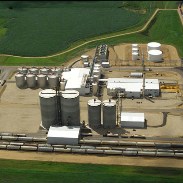VeraSun to become largest ethanol firm

VeraSun Energy Corp., one the nation’s largest ethanol producers, is boosting its capacity by about a third with the early opening of its third biorefinery in Charles City , Iowa.
When this plant
reaches full production it will be able to produce 110 million gallons of
ethanol each year using more than 39 million bushels of corn. The plant will
also yield 350,000 tons of dried
distillers’ grains as a byproduct of the ethanol
process.
VeraSun operates
near-identical ethanol plants in Fort Dodge,
identical plants the company can share and homologise procedures, staff and
spare parts which will contribute to efficiency.
The
schedule, boosts the company’s production capacity to about 340 million gallons
per year.
VeraSun has two additional plants under
construction in
Hartley
Iowa
Minnesota
capacity to about 560 million gallons. This week the company has chosen
biorefinery.
Processing DDGS
All of VeraSun’s
plants produce dried distillers grains, but the company eventually plans to
extract oil from the grains to also produce biodiesel.
This process offers a double benefit because it gives VeraSun an
additional product while improving the value of its distillers grain. DDGS,
because of its fat content, can only be fed to a certain level to livestock. By
removing the fat (for biodiesel), livestock producers and dairymen will be able
to increase the volume fed per animal and ultimately obtain a better value for
protein feedstock.
VeraSun has had success
drawing out oil in small- and large-scale tests and will begin construction of
its first extraction facility next to its
The company plans similar projects at its other biorefineries.
Huge corn
crop
US farmers are expected to plant the largest
crop (+15%) of corn since 1944, according to the Department of
Agriculture.
With six plants up and running
VeraSun will require around 240,000 bushels of corn and produce more than 2
million tonnes of DDGS.
A VeraSun spokesman said the additional area will more than
satisfy growing demand for ethanol, but VeraSun is also examining ways to use
plant waste such as corn stalks to convert the cellulose into
ethanol.
Related folder:
Dossier AllAbout Bio Energy











